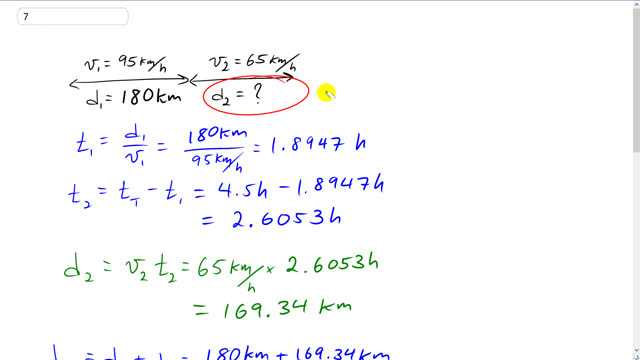
You are driving home from school steadily at 95 km/h for 180 km. It then begins to rain and you slow to 65 km/h. You arrive home after driving 4.5 h.
- How far is your hometown from school?
- What was your average speed?

In order to watch this solution you need to have a subscription.
This is Giancoli Answers with Mr. Dychko. So the first 180 kilometers from school is traveled at 95 kilometers an hour and the next unknown distance, after which it starts raining, is traveled at 65 kilometers an hour. So we know that the total time spent traveling is 4.5 hours and so we'll figure out how much time is spent during this second interval by taking the total time of 4.5 and subtracting the time spent traveling the first interval and then we'll figure out what the length of this d 2 is by multiplying by the speed v 2— 65 kilometers an hour— times the amount of time spent traveling in the second interval. And then we'll just add the two distances together to get our total. So we have the time spent in the first interval is the 180 kilometers divided by 95 kilometers an hour which is 1.8947 hours and then we'll take 4.5 minus that result to get 2.6053 hours is the time spent traveling at 65 kilometers an hour. And so d 2 is gonna be v 2— 65 kilometers an hour— times this 2.6053 hours which means it's 169.34 kilometers. And so the total distance then is the 180 kilometers traveled initially plus a 169.34 kilometers which gives a total of 3.5 times 10 to the 2 kilometers. And the average speed is the total distance divided by the total time and that's gonna make 78 kilometers per hour and a common mistake that you are not gonna make because I'm telling you not to right now is you cannot take the 95 kilometers per hour and add 65 kilometers per hour and divide by 2. This, you know, is a typical type of arithmetic to do for calculating averages but it does not work in this case because you spent different amounts of time traveling at these different speeds; if you feel like making things complicated, you could take a time-weighted average, you know, this is not something we are actually gonna do but just so you can see how this arithmetic that you are probably familiar with does actually relate to this question you could say, 95 kilometers per hour times by 1.89 out of the total 4.5 and then add that to 65 times the 2.6 hours out of the 4.5— that should probably get the right answer— I'm just curious myself, let's see what happens— hopefully things work out the way they are supposed to 95 times 1.89 over 4.5 plus 65 times 2.6 out of 4.5 divided by 2 well, it didn't work oh yeah, never mind the divide by 2 that's what you do there so right. So you are just taking a time-weighted average is just a take this, multiply it by the fraction of time during which it applies and then add that to 65 kilometers an hour multiply it by the fraction of time for which it applies and never mind this divide by 2; this divide by 2 thing is implies the assumption that all the things that you are taking an average of apply equally. So if you had a whole bunch of speeds that all occurred for the same duration of time then you could take speed 1 and then speed 2 and then speed 3 and then you could divide by 3 sure because each of them is valid for one-third of the time. So essentially this when you have this whole divide by 3 thing, it really is the same arithmetic as I'm doing here; you are multiplying each thing by the fraction of time during which it applies but instead of multiplying each thing by a third, it's just easier to write that as divide by 3 as a shortcut and anyway, hopefully haven't digressed too much. But what you are actually gonna do in your calculations is this simple idea of total distance divided by total time that's your average speed— end of story there.
there is a change in velocity from 95 to 65, why we don't use kinematics equation?